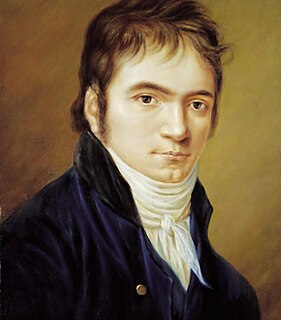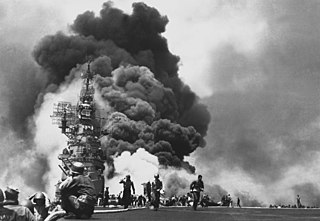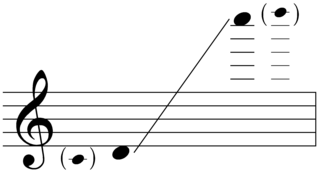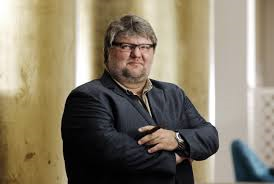
The Symphony No. 1 in F minor by Dmitri Shostakovich was written in 1924–1925, and first performed in Leningrad by the Leningrad Philharmonic under Nikolai Malko on 12 May 1926. Shostakovich wrote the work as his graduation piece at the Petrograd Conservatory, completing it at the age of 19.
Concerto in F is a composition by George Gershwin for solo piano and orchestra which is closer in form to a traditional concerto than the earlier jazz-influenced Rhapsody in Blue. It was written in 1925 on a commission from the conductor and director Walter Damrosch. It is just over half an hour long.

The Piano Concerto No. 3 in C minor, Op. 37, was composed by Ludwig van Beethoven in 1800 and was first performed on 5 April 1803, with the composer as soloist. The year for which the concerto was composed (1800) has however been questioned by contemporary musicologists. It was published in 1804. During that same performance, the Second Symphony and the oratorio Christ on the Mount of Olives were also premiered. The composition was dedicated to Prince Louis Ferdinand of Prussia. The first primary theme is reminiscent of that of Mozart's 24th Piano Concerto.

Ludwig van Beethoven's Symphony No. 1 in C major, Op. 21, was dedicated to Baron Gottfried van Swieten, an early patron of the composer. The piece was published in 1801 by Hoffmeister & Kühnel of Leipzig. It is not known exactly when Beethoven finished writing this work, but sketches of the finale were found to be from 1795.

Felix Mendelssohn's Violin Concerto in E minor, Op. 64, is his last large orchestral work. It forms an important part of the violin repertoire and is one of the most popular and most frequently performed violin concertos in history. A typical performance lasts just under half an hour.

The Piano Concerto No. 1 in B♭ minor, Op. 23, was composed by Pyotr Ilyich Tchaikovsky between November 1874 and February 1875. It was revised in the summer of 1879 and again in December 1888. The first version received heavy criticism from Nikolai Rubinstein, Tchaikovsky's desired pianist. Rubinstein later repudiated his previous accusations and became a fervent champion of the work. It is one of the most popular of Tchaikovsky's compositions and among the best known of all piano concertos.
The Piano Concerto, Op. 38, by Samuel Barber was commissioned by the music publishing company G. Schirmer Inc. in honor of the centenary of their founding. The work's premiere was on September 24, 1962, in the opening festivities of Philharmonic Hall, now David Geffen Hall, the first hall built at Lincoln Center for the Performing Arts in Manhattan, with John Browning as soloist with the Boston Symphony Orchestra conducted by Erich Leinsdorf.
Piano Concerto No. 4 in C minor, Op. 44 by Camille Saint-Saëns, is the composer's most structurally innovative piano concerto. In one sense it is structured like a four-movement symphony, but these are grouped in pairs. That is, the piece is divided into two parts, each of which combines two main movements. However, in each part there is a bridge-like transitional section, between the two main "movements" – for example, a fugal Andante in part II functions as an interlude between the two main triple-meter sections.
- Allegro moderato – Andante
- Allegro vivace – Andante – Allegro

Symphony No. 2 in E minor, Op. 27, is a symphony by the Russian composer Sergei Rachmaninoff, written in 1906–07. The premiere was conducted by the composer himself in Saint Petersburg on 8 February 1908. Its duration is approximately 60 minutes when performed uncut; cut performances can be as short as 35 minutes. The score is dedicated to Sergei Taneyev, a Russian composer, teacher, theorist, author, and pupil of Pyotr Ilyich Tchaikovsky. Alongside his Piano Concerto No. 2 and Piano Concerto No. 3, this symphony remains one of the composer's best known compositions.
Piano Concerto No. 3 in C major, Op. 26, is a piano concerto by Sergei Prokofiev. It was completed in 1921 using sketches first started in 1913.

Hisato Ohzawa was a Japanese composer. His relative neglect today contrasts with the view that he was one of the preeminent Japanese composers of his day.

Pyotr Ilyich Tchaikovsky's Piano Concerto No. 3 in E-flat major, Op. posth. 75, was originally begun as a Symphony in E-flat. The composer ultimately abandoned this symphony, but, in 1893, started to rework it into a piano concerto, before abandoning all but the first movement, which he completed as a concert piece for piano and orchestra. It was published posthumously, in 1894, as a single-movement Allegro Brillante. The Symphony No. 6 Pathétique was the last of Tchaikovsky's compositions to be performed in his lifetime, but the Allegro Brillante, now known as the Piano Concerto No. 3, was his last completed composition.
Francis Poulenc's Concerto pour deux pianos in D minor, FP 61, was commissioned by and dedicated to the Princess Edmond de Polignac and composed over the period of three months in the summer of 1932. It is often described as the climax of Poulenc's early period. The composer wrote to the Belgian musicologist Paul Collaer: "You will see for yourself what an enormous step forward it is from my previous work and that I am really entering my great period." Poulenc composed the concerto for the Princess Edmond de Polignac, an American-born arts patron to whom many early 20th-century masterpieces are dedicated, including Stravinsky’s Renard, Ravel’s Pavane pour une infante défunte, Kurt Weill’s Second Symphony, and Satie’s Socrate. Her Paris salon was a gathering place for the musical avant-garde.
Aram Khachaturian wrote his Cello Concerto in E minor in 1946 for Sviatoslav Knushevitsky. It was the last of the three concertos he wrote for the individual members of a renowned Soviet piano trio that performed together from 1941 until 1963. The others were: the Piano Concerto for Lev Oborin (1936); and the Violin Concerto for David Oistrakh (1940).
The Piano Concerto No. 3 in E minor "Ballade", Op. 60, was one of Nikolai Medtner's last major compositions, completed in 1943, when he was 63.
The Concerto for Piano and Orchestra is a piano concerto by the American composer John Corigliano. The work was commissioned by the San Antonio Symphony and was first performed on April 7, 1968 by the pianist Hilde Somer and the San Antonio Symphony under the direction of Victor Alessandro. The piece is dedicated to John Atkins.
The Piano Concerto No. 1, Op. 28, is the first piano concerto by the Argentinian composer Alberto Ginastera. The work was commissioned by the Koussevitzky Foundation and was completed in 1961. It was first performed by the pianist João Carlos Martins and the National Symphony Orchestra conducted by Howard Mitchell in Washington, D.C., on April 22, 1961. The concerto was Ginastera's first composition for piano since his Piano Sonata No. 1, Op. 22, written in 1952. It is dedicated to the memory of Serge and Natalie Koussevitzky.
The Symphony No. 3 is a composition for orchestra by the American composer Ned Rorem. The work was first performed by the New York Philharmonic under the direction of Leonard Bernstein at Carnegie Hall on April 16, 1959.
The Piano Concerto No. 2 in D minor, Op. 23 by Edward MacDowell was completed in late 1885. Although some obvious similarities with Edvard Grieg's, Camille Saint-Saëns's and Franz Liszt's concertos have often been stated, MacDowell’s composition proves to be quite original, at least it shows much more originality than his First Concerto. It was the first major piano concerto written by an American. It was also the only large-scale composition by MacDowell to remain in standard repertoire.
Symphony No. 4 in E-flat major is an orchestral work by Swedish composer Franz Berwald written in 1845. Berwald considered naming the symphony "Sinfonie naïve" but the autograph score is simply inscribed "No. 4 in E flat". Berwald attempted to interest French composer/conductor Daniel Auber in premiering the symphony but it had to wait until April 9, 1878 when it was finally given a first performance under Berwald champion Ludvig Norman.


















